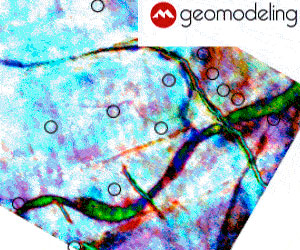Articles

Recent Developments in Wave Equation Migration
Christof Stork, Uwe Albertin, Clement Kostov, Dave Yingst, Jerry Kapoor
As a result of recent developments, prestack wave equation migration is capable of producing dramatically improved sub-salt images over Kirchhoff depth migration and has become a hot technology in the Gulf of Mexico. It is possible that wave equation migration can help in other high velocity contrast areas such as…

Rock Physics of Geopressure and Prediction of Abnormal Pore Fluid Pressures Using Seismic Data: Part 1
José M. Carcione and Hans B. Helle
Various physical processes cause anomalous pressures of underground fluids in a petroleum province. We quantify the effect on seismic properties caused by the common mechanisms of overpressure generation such as (kerogen-to-oil and oil-to-gas conversion) disequilibrium compaction. Fluid pressure due to kerogen-to-oil conversion in source rock shale significantly reduces the seismic…

Rock Physics of Geopressure and Prediction of Abnormal Pore Fluid Pressures Using Seismic Data: Part 2
José M. Carcione and Hans B. Helle
Various physical processes cause anomalous pressures of underground fluids in a petroleum province. We quantify the effect on seismic properties caused by the common mechanisms of overpressure generation such as (kerogen-to-oil and oil-to-gas conversion) disequilibrium compaction. Fluid pressure due to kerogen-to-oil conversion in source rock shale significantly reduces the seismic…

Seismic Detection and Estimation of Overpressures Part I: the Rock Physics Basis
Nader Dutta, Tapan Mukerji, Manika Prasad, and Jack Dvorkin
This paper describes the rock physics basis of understanding and better defining seismic signatures of overpressures (defined as the pore fluid pressure in excess of the hydrostatic pressure). Our accompanying paper describes applications of these fundamental rock models for estimating pore pressures from field seismic data. The physical basis for…

Seismic Detection and Estimation of Overpressures Part II: Field Applications
Nader Dutta, Tapan Mukerji, Manika Prasad, and Jack Dvorkin
Subsurface formations with pore fluid pressure in excess of the hydrostatic pressure (geopressure) are encountered worldwide. Although there are a multitude of causes that can result in geopressure, under compaction due to rapid burial of sediments is the predominant cause of geopressure. Typically, if the loading process is rapid, fluid…

Challenges Of Porosity-Based Pore Pressure Prediction
Richard. E. Swarbrick
Newly emerging plays with high reserves replacement potential include the deep-water sediments of ocean margins worldwide, sub-salt reserves and high-pressure high-temperature environments, all of which are subject to significant overpressure, that is pore pressures above “normal” or hydrostatic. In each of these environments the pore pressures can reach values as…

Dimensionless Gradients Applied To Pore Pressure Prediction – A New Standard
Martin Traugott and Richard Swarbrick
Given the cost of controlling problems associated with drilling pore pressure surprises, it is important to develop concise methods for predicting pressure gradients ahead of the bit. This paper sets out a new standard for working with gradients and explores the Eaton relationship between gradients and seismic velocity. A main…

Pore Pressure Estimation – What Can We Learn From 4D?
M. Landrø and Øyvind Kvam
Most methods for pressure prediction from seismic are based on detection of low velocity anomalies. The significant growth of time-lapse seismic surveys gives us a possibility to check the robustness and limitations of these classical prediction methods, and might also lead to new methods for pressure prediction that can be…

Sequence Stratigraphy: Key to Geopressure Profile Assessment
Selim S. Shaker
Lithology and principal stress are the main driving mechanisms behind the development of the subsurface geopressure profile. Lithology distribution creates the conditions that lead to compartmentalization. Sequence/seismic stratigraphy are good guide lines to establish the paleoenvironment and sediment’s spatial distribution in a basin. The overburden (principle stress) is a result…

Effects of Stress and Pore Fluid Pressure on Seismic Anisotropy in Cracked Rock
Enru Liu, Simon R. Tod and Xiang-Yang Li
The cracks in sedimentary rock that is subjected to a change in the applied stress or fluid pressure will undergo a distortion related to their orientation relative to the principal directions of the applied stress. Both the crack distribution and the fluid-flow properties will be altered as a consequence of…

Embracing Today’s Interpretation Technologies. The tools are here, the time is now.
James Lamb
Now, more than ever, the oil and gas industry is in a race to increase productivity. The impact of decisions made today in adopting new technologies and processes will define success in the next decade. Interpreters in today's oil and gas industry are challenged by many factors. Ways to increase…

Changing Visualization Technology
John Prutzman
Consider this scenario: you are given a 3-D survey known to contain channel sands within a prospective interval. Your job is to quickly identify potentially interesting prospects. To accomplish this quickly, which view would you prefer?
...
Choosing the Right Virtual Environment
Theo Mayer
Nearly all producers in the oil/gas industry are now faced with weighing the benefits of an investment in large-scale visualization, a technology that has had profound effects on upstream development and existing field production for the major oil companies. The financial and human resource commitment to a visualization methodology is…

Thinking Inside the Box
Murray Christie
What makes visualization such a powerful enabler of human memory is its ability to enhance visual patterns from the data in 3D space, enable recognition, organization and classification of meaningful geological patterns and allow the direct inference of depositional environments. In the same way in which viewing a meandering channel…

Inside Reality: Extreme Immersion Elevates Virtual Reality to a New Level
Phil Hodgson
Visualization and virtual reality technologies conjured up visions of elitist, other-worldly usage when they first gained notoriety for oil industry purposes in the mid-1990s. However, such applications rather quickly morphed from the perceived esoteric realm to the everyday, becoming almost de rigueur now for any number of E&P uses. Still,…

Human Factors in Visual Collaboration
Dave Ridyard
Large scale visualization systems have moved from the fringes of our industry to become integral to daily workflows at many oil and gas companies. Visualization is not about visualizing our own data. It is about how we share knowledge with each other. It is a key element in interdisciplinary collaboration.…

Dream, Dare, Do
Jeff MacInnis
Audiences love the message that Jeff MacInnis delivers. As the leader of the first team to sail the Northwest Passage, captain of a top 10 Eco-Challenge Team, a World Cup downhill ski racer, best-selling author and entrepreneur, Jeff delivers a “must-see” multimedia presentation. Using National Geographic images and television footage…

Canadian Seismic With a Thump
Dave Monk
The potential for recording seismic data in forestry areas of Canada using novel weight drop systems has been examined. Some methods tested yielded data which is comparable with conventional dynamite data, but at potentially less cost, with the additional benefit of minimizing any environmental impact. The impact energy for a…

Delineation of Steam Flood Using Seismic Attenuation
Ken Hedlin, Larry Mewhort and Gary Margrave
The possible use of attenuation measurements for time-lapse seismic monitoring of an EOR steam flood project in Saskatchewan, Canada is investigated. A VSP survey was used to calculate Q. These values were input to a synthetic seismogram attenuation modeling program that showed there should be an observable increase in attenuation…

2D and 3D Anisotropic Depth Migration Case Histories
Rob Vestrum
Anisotropic depth migration (ADM) has become more commonplace over the past four years. The data-processing examples detailed here illustrate the robustness of the method in a variety of structured settings in the Alberta Foothills. The public-domain structural line, the Husky/Talisman dataset, illustrates subtle improvements in imaging with a dramatic improvement…









